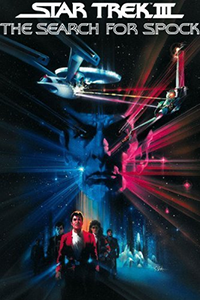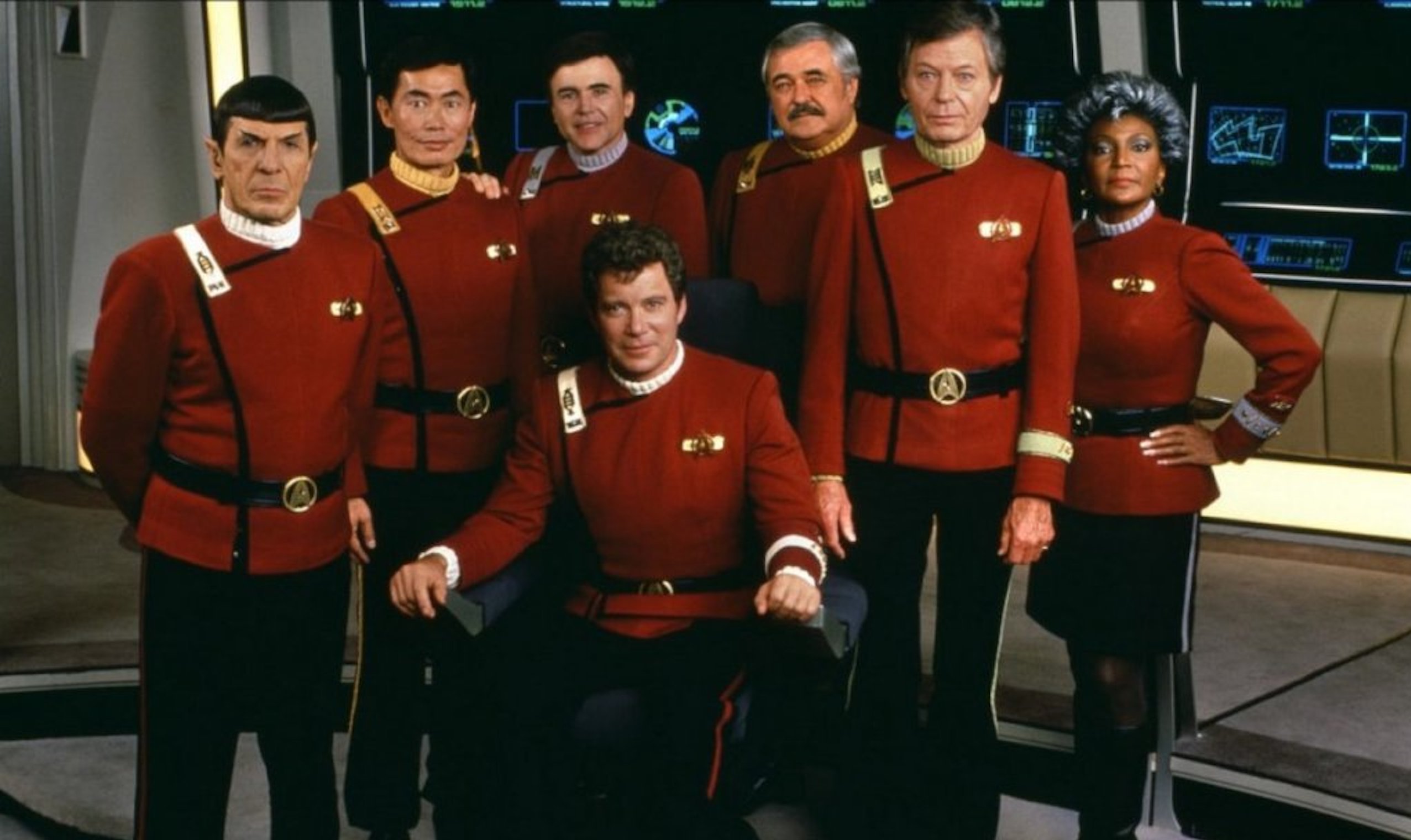With the latest Star Trek film, Star Trek into Darkness, coming out on DVD, now is a good time to recount the virtues of the original films, which date back to 1979 and are worth watching or rewatching, as the case may be. Viewers of the newest film, which includes many of the same characters as the original films but in an altered timeline, will notice numerous interesting parallels to the stories of the originals.
Star Trek: The Motion Picture
Directed by Robert Wise.Story by Alan Dean Foster.
Screenplay by Harold Livingston.
Starring William Shatner, Leonard Nimoy, DeForest Kelley, James Doohan, George Takei, Walter Koenig, Nichelle Nichols, and Persis Khambatta.
Distributed by Paramount Pictures.
Released December 7, 1979.
Rated PG for sci-fi action and mild language.
Running Time: 132 minutes.
Star Trek, the original series, first aired on television from 1966 to 1969. Due to the series’s popularity in syndication, as well as the popularity of the 1977 science-fiction films Star Wars and Close Encounters of the Third Kind, Paramount Pictures decided to reinvigorate its major science-fiction property as a film. The result was Star Trek: The Motion Picture.
Of all the Trek films, the original fits best in the genre of classic sci-fi. It is also the film with the least physical action. The story involves the crew of the starship Enterprise and its interactions with a strange being from the distant reaches of space, a machine on a quest to join its creator. This gigantic space-faring machine, surrounded by a mysterious cloud, attacks ships it regards as threatening. In an attempt to communicate with the crew of the Enterprise, the machine kidnaps and duplicates a crew member, killing her in the process.
With its psychedelic portrayal of the machine’s inner being (into which the Enterprise travels) and its jangling soundtrack, this film is rather dated. Thankfully, the performances make the best of the material, and Persis Khambatta creates an especially memorable character as the duplicated crew member.
Thematically, the film leaves little to remember it by (although Freudians could have a field day analyzing its portrayal of a machine trying to “merge” with its creator). But the film is good, classic science fiction, and it is a work that will continue attracting the interest of science-fiction fans.
Star Trek II: The Wrath of Khan
Directed by Nicholas Meyer.
Story by Harve Bennett, Jack B. Sowards, and Samuel A. Peeples.
Screenplay by Jack B. Sowards and Nicholas Meyer.
Starring William Shatner, Leonard Nimoy, DeForest Kelley, James Doohan, George Takei, Walter Koenig, Nichelle Nichols, Kirstie Alley, and Ricardo Montalbán.
Distributed by Paramount Pictures.
Released June 4, 1982.
Rated PG for violence and language.
Running Time: 113 minutes.
In The Wrath of Khan, released in 1982, Ricardo Montalbán—then famous for leading the television series Fantasy Island—creates the most memorable Star Trek villain, Khan Noonien Singh, a maniacal but intelligent man bent on the destruction of James T. Kirk, former captain of the Enterprise and now an admiral in Star Fleet.
Khan, long exiled by Kirk to a remote planet, escapes when two men from Star Fleet visit his planet while on a mission related to Project Genesis, involving an astounding terraforming technology. Khan seeks to steal a starship, steal the Genesis technology—which would be incredibly dangerous in the wrong hands—and destroy Kirk and the Enterprise. Naturally, Kirk swings into action to stop him.
The story is interesting enough for a sci-fi action film, and the villain is spectacular, but the movie shines brightest in its interactions among the crew of the Enterprise. The main characters, particularly Kirk (William Shatner), Spock (Leonard Nimoy), and “Bones” McCoy (DeForest Kelley), generate a charisma that the rebooted films have not been able to fully recapture. Although some critics unfairly mock Shatner’s acting, the performances, especially of these three actors, are consistently first-rate.
Discussions among these three main characters frame the themes of the film, one dealing with appreciating life and coping with aging. The film begins with Kirk lamenting another birthday while working at a desk rather than at the helm of a starship. McCoy visits Kirk to wish him a happy birthday, but he quickly grows frustrated, saying, “Damn it, Jim, what the hell’s the matter with you? Other people have birthdays. Why are we treating yours like a funeral?” But, after returning to command a starship, and especially after witnessing the life-generating power of the Genesis technology, Kirk discovers his second youth.
Spock sets up another major theme of the film when, early on, he offers Kirk the captain’s chair of the Enterprise. He says, “Logic clearly dictates that the needs of the many outweigh the needs of the few.” Consideration of this refrain, and debate about it, set the tone not only for The Wrath of Khan but for the subsequent two Trek films as well. (Spock’s comment is demonstrably false, but that’s a topic for another day.)
The Wrath of Khan ends in a tragedy that sets up the next film beautifully.
Star Trek III: The Search for Spock
Directed by Leonard Nimoy.
Written by Harve Bennett.
Starring William Shatner, Leonard Nimoy, DeForest Kelley, James Doohan, George Takei, Walter Koenig, Nichelle Nichols, Robin Curtis, and Christopher Lloyd.
Distributed by Paramount Pictures.
Released June 1, 1984.
Rated PG.
Running Time: 105 minutes.

As anyone familiar with the Star Trek universe knows, Spock lives a long life. So, despite his apparent death in the second film, Spock cannot actually be dead; and we learn in the third film that he is in fact alive, even if not all in one place. In the third film, Spock’s Enterprise friends journey to find him and help restore his mind.
The film begins with Kirk mourning over his (apparently) lost friend and with McCoy apparently going mad. Clearly, the loss of Spock has thrown the lives of his closest friends out of kilter. But Spock’s father visits Kirk and suggests that his son might not be dead, that he might be alive but somehow disintegrated, and that it might be possible to help him. In response to this news, Kirk conspires with his former crewmates to steal the Enterprise and to recover and reunite Spock’s body and mind.
Naturally, this will not be easy. When a Klingon commander named Kruge (memorably portrayed by Christopher Lloyd) hears of the Genesis Project and determines to steal its technology for use as a weapon, he puts himself on a collision course with Kirk and the crew of the Enterprise.
This film, more than any other in the Trek universe, focuses on friendship and family. Spock’s friends seek to save him, Kirk reunites with his son, a Vulcan named Saavik acts as Spock’s protector while he is in a vulnerable state, and Spock’s father pleads with Kirk to aid him in helping Spock. These relationships give the film heart.
In this film and the next, not only does Leonard Nimoy portray Spock; he directs the film beautifully as well.
Star Trek IV: The Voyage Home
Directed by Leonard Nimoy.
Story by Leonard Nimoy and Harve Bennett.
Screenplay by Steve Meerson, Peter Krikes, Harve Bennett, and Nicholas Meyer.
Starring William Shatner, Leonard Nimoy, DeForest Kelley, James Doohan, George Takei, Walter Koenig, Nichelle Nichols, and Catherine Hicks.
Distributed by Paramount Pictures.
Released November 26, 1986.
Rated PG.
Running Time: 119 minutes.
In 1975, Greenpeace launched its “save the whales” campaign. This and similar efforts led to the premise of Star Trek IV: The Voyage Home, in which the goal of Kirk and his crew is to save the humpback whale from extinction and to save the human race in the process.
The premise of the film is ridiculous. The idea is that some civilization from the far reaches of space lost contact with Earth’s whales (how they ever got such contact remains a mystery), so they send a giant probe to Earth to try to find the whales. The whales by this time are extinct due to human hunting. Apparently the distant civilization is smart enough to build an advanced space probe that travels to earth but not smart enough to figure out the cause of the whales’ demise.
What does this have to do with Kirk and his crew? The probe leaves destruction in its wake and threatens (unintentionally) to destroy the human population of Earth. Kirk’s plan, as stated with disbelief by McCoy: “You are proposing to head backwards in time, find humpback whales, then bring them forward in time, drop them off, and hope to hell they tell this probe what to do with itself!”
Despite its silly premise, this film is arguably the best Trek film. Besides evoking sympathy for whales and inspiring curiosity about these magnificent creatures, the film is hilarious. When the Enterprise travels back in time, it lands in late-20th century America, leading to “fish-out-of-water” humor as crew members seek to repair their ship, modify it to carry whales, and locate suitable whales for transport.
As an example of this humor, Spock notices that the Earth’s inhabitants use “colorful metaphors,” so he joins in. After he swims with a pair of whales in captivity, an employee of the oceanic facility holding the whales grills Spock: “Who the hell are you? What were you doing in there?” Spock answers calmly, “Attempting the hell to communicate.” Kirk says Spock was only trying to help. The employee retorts, “The hell you were, buster. Your friend was messing up my whales.” Spock interjects, “They like you very much, but they are not the hell your whales.” Furious, the employee fires back, “I suppose they told you that?” Spock finishes, “The hell they did.” Humor on this order had me chuckling through most of the film.
Although the premise of the film both weakens and dates it, The Voyage Home remains a fun action-adventure movie.
Star Trek V: The Final Frontier
Directed by William Shatner.
Story by William Shatner, Harve Bennett, and David Loughery.
Screenplay by David Loughery.
Starring William Shatner, Leonard Nimoy, DeForest Kelley, James Doohan, George Takei, Walter Koenig, Nichelle Nichols, and Laurence Luckinbill.
Distributed by Paramount Pictures.
Released June 9, 1989.
Rated PG.
Running Time: 107 minutes.
The Final Frontier tells a bizarre story, and Shatner’s directing leaves much to be desired, but the film does have some redeeming qualities that make it worth viewing.
The premise of this film is perhaps even more ludicrous than that of the previous one. A renegade Vulcan named Sybok has created a cult with the goal of locating God. Somehow, Sybok has received a message from a being at the center of the galaxy claiming to be God. So Sybok seeks to steal a starship and find this being, and he takes the crew of the Enterprise along for the ride, using his Vulcan powers of mind control in the process. (The “God” he finds is not what he expected.)
Although the film misses an opportunity to take a penetrating look at religion, it does call into question common claims about the nature of God, and so it is as critical of religion as we might expect of a popular, action-oriented film produced in a predominantly religious society.
The film is enjoyable for two main reasons. First, the interplay among the main characters is humorous and benevolent. For example, the film opens and closes with Kirk, Spock, and McCoy camping and singing campfire songs as they consider the meaning of their lives. At one point, McCoy explodes at Spock for contemplating the meaning of “Row, Row, Row Your Boat” rather than singing it: “It’s a song, you green-blooded Vulcan. You sing it. The words aren’t important. What’s important is that you have a good time singing it.”
The other interesting aspect of the film involves Sybok forcing McCoy and Spock to relive especially painful parts of their lives. Sybok does this to all of the inductees of his cult as a means of making them feel intense guilt followed by a cathartic release, the goal being to foster dependence on Sybok for his “spiritual” leadership. In these intense scenes, McCoy faces the death of his father, and Spock faces his father’s disappointment that Spock is half human. But Kirk refuses to take part in Sybok’s charade or to accept unearned guilt.
Despite its shortcomings, The Final Frontier is an interesting adventure.
Star Trek VI: The Undiscovered Country
Directed by Nicholas Meyer.
Story by Leonard Nimoy, Lawrence Konner, and Mark Rosenthal.
Screenplay by Nicholas Meyer and Denny Martin Flinn.
Starring William Shatner, Leonard Nimoy, DeForest Kelley, James Doohan, George Takei, Walter Koenig, Nichelle Nichols, Kim Cattrall, David Warner, and Christopher Plummer.
Distributed by Paramount Pictures.
Released December 6, 1991.
Rated PG.
Running Time: 113 minutes.
Of the original Trek films, The Undiscovered Country is the only one with an overtly political storyline. The United Federation of Planets (which includes Earth) has long been in conflict with the Klingon Empire. But now a Klingon moon—also the site of an energy complex—has exploded, crippling the empire and elevating the credibility of those Klingons calling for peace.
Although Spock favors peace, Kirk, given his violent history with the Klingons, initially regards peace negotiations as madness. When a Klingon ambassador is murdered, Kirk is framed for the job, so the crew of the Enterprise must uncover the conspiracy aimed at undermining the peace talks.
The film’s value lies in its characters and their relationships. Spock believes he has found his protégé in a bright young Vulcan named Valeris. Kirk interacts with two interesting Klingons, Chancellor Gorkon, the stately and forward-looking ambassador of peace; and Chang, a Shakespeare-quoting warmonger. Kirk and McCoy must get themselves out of a tough jam, and in the process they meet a seductive alien (portrayed by the sultry model Iman).
Chancellor Gorkon unintentionally summarizes the spirit of the entire Star Trek franchise when he says, “I offer a toast—the undiscovered country, the future.”
* * *
Although many of Gene Roddenberry’s ideas as presented in Star Trek are philosophically objectionable, he offers people what many desperately need: a vision of a hopeful future.
In the world he created, mankind flies through the universe using wondrous technologies, leaving behind racism and mysticism. This is why the original Star Trek was so successful, this is why the original films retain their appeal, and this is why Paramount Pictures continues to develop the franchise.
On top of that, the main actors of the original cast, particularly Shatner, Nimoy, and Kelley, created a benevolent and intelligent atmosphere in which their characters built friendships, and contemplated and debated the mysteries of the universe.
Star Trek fuels us to voyage into that “undiscovered country, the future” with the conviction that ideas matter and that technology is good. This, not coincidentally, is the conviction necessary to succeed in the Final Frontier.
















